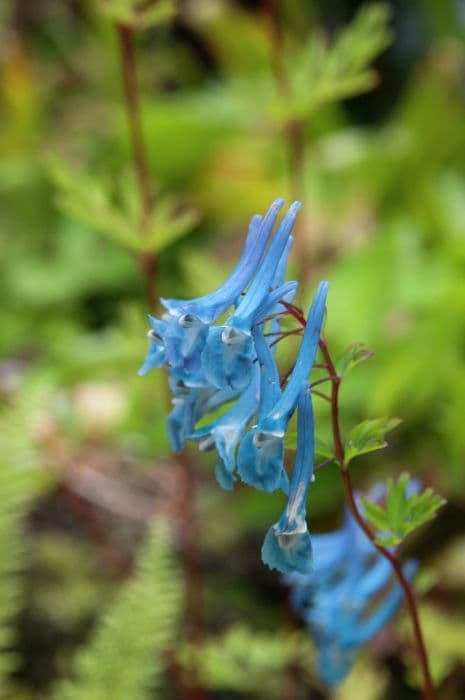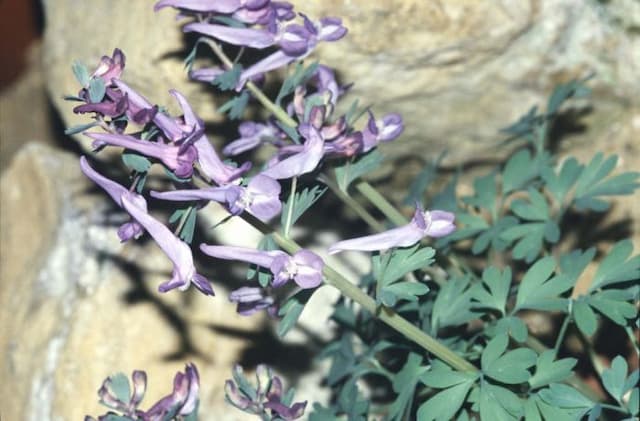Spinners Corydalis Corydalis 'Spinners'

ABOUT
Corydalis 'Spinners' is a captivating plant with a distinct appearance characterized by its delicate and finely divided, fernlike blue-green foliage. The leaves provide an elegant backdrop to the show-stopping flowers, which are the true highlight. These blossoms are tubular and elongated, resembling little spurred helmets, and they dangle gracefully from slender arched stems. The flowers exhibit a harmonious blend of color, transitioning from a deep lavender-blue at the tips to soft lavender shades, and sometimes they have hints of yellow at the throat, which adds an extra layer of visual interest to the overall display. The plant blooms profusely during the cooler months of spring and oftentimes into early summer, creating a soft, romantic effect in the garden. Corydalis 'Spinners' has a gentle, airy quality that makes it an excellent choice for adding movement and subtle color to shaded or partially shaded garden areas. Its appearance seems to evoke a cottage garden charm that can soften the landscape and provide an enchanting visual experience.
About this plant
 Names
NamesFamily
Papaveraceae
Synonyms
Fumewort, Bleeding Heart
Common names
Corydalis 'Spinners'.
 Toxicity
ToxicityTo humans
Corydalis 'Spinners', commonly known as Spinners, contains alkaloids that can be toxic if ingested in significant quantities by humans. The consumption of this plant can lead to various symptoms such as nausea, vomiting, dizziness, and confusion. In severe cases, it may affect the central nervous system and can potentially lead to respiratory issues or coma if a large quantity is consumed. Any ingestion of this plant should be taken seriously and medical advice should be sought immediately.
To pets
Spinners contains alkaloids that are also toxic to pets if ingested. The consumption of this plant by pets can lead to similar symptoms as seen in humans such as vomiting, diarrhea, uncoordinated movements, and lethargy. In more severe situations, it can lead to tremors, seizures, and potentially even respiratory failure. If a pet ingests any part of this plant, it is essential to seek veterinary attention immediately.
 Characteristics
CharacteristicsLife cycle
Perennials
Foliage type
Deciduous
Color of leaves
Green
Flower color
Blue
Height
1-2 feet (30-60 cm)
Spread
1 foot (30 cm)
Plant type
Herb
Hardiness zones
5
Native area
Europe
Benefits
 General Benefits
General Benefits- Ornamental Appeal: Corydalis 'Spinners' has attractive blue-purple flowers and finely divided, fern-like foliage that adds aesthetic interest to gardens.
- Extended Blooming Season: This plant has a long flowering period, usually from late spring to early fall, providing persistent color in the landscape.
- Attracts Pollinators: The flowers of Corydalis 'Spinners' attract bees and other pollinators, supporting biodiversity.
- Shade Tolerance: It thrives in partially shaded environments, which makes it suitable for woodland gardens or shaded borders.
- Low Maintenance: Corydalis 'Spinners' is known for being low maintenance, requiring minimal care once established.
- Deer Resistant: This plant is generally resistant to deer, which can be beneficial in areas where deer predation is a concern for gardeners.
 Medical Properties
Medical PropertiesThis plant is not used for medical purposes.
 Air-purifying Qualities
Air-purifying QualitiesThis plant is not specifically known for air purifying qualities.
 Other Uses
Other Uses- Corydalis 'Spinners' can be used as a natural dye, with different parts of the plant yielding various hues that can stain fabrics or be used in crafts.
- The crushed foliage of Corydalis may be used as a natural insect repellent in gardens, as the scent is often disliked by pests.
- Dried Corydalis flowers can be incorporated into potpourri mixes, adding a unique shape and a delicate fragrance to the mixture.
- Corydalis can be used in floral arrangements to provide a delicate, fern-like texture and a splash of color.
- The plant makes an attractive ground cover in shaded areas where other plants might struggle to grow.
- Used in landscape design, Corydalis 'Spinners' can help to prevent soil erosion on slopes due to its spreading habit.
- The plant can serve as a living mulch, keeping the soil moist and cool while adding aesthetic value to garden beds.
- Corydalis can be planted in woodland gardens to create a more naturalized setting that requires minimal maintenance.
- Its seeds can be used to propagate new plants in a hobbyist's nursery as they are relatively easy to germinate under the right conditions.
- The nectar-rich flowers of Corydalis 'Spinners' are excellent for attracting pollinators like bees and butterflies to the garden, enhancing pollination of surrounding plants.
Interesting Facts
 Feng Shui
Feng ShuiThe Corydalis is not used in Feng Shui practice.
 Zodiac Sign Compitability
Zodiac Sign CompitabilityThe Corydalis is not used in astrology practice.
 Plant Symbolism
Plant Symbolism- Escape: The Corydalis plant, also known as Fumewort, has been associated with the idea of escape due to its ability to thrive in tough conditions, offering a metaphor for finding a way out even in difficult situations.
- Elusiveness: Fumewort possesses a delicate appearance and can sometimes be difficult to find as it blends into its natural woodland settings, symbolizing elusiveness and the hidden beauty in nature.
- Adaptability: Fumewort is known for its adaptability to various environments, which makes it a symbol of flexibility and the ability to adjust to different situations in life.
 Water
WaterThe Bleeding Heart (Corydalis 'Spinners') appreciates moist soil, so it's important to water it whenever the top inch of soil feels dry. A good approach is to check the moisture level once or twice a week and water accordingly. During the growing season in spring and summer, you might find that it needs water once or twice a week. Provide about 1 gallon of water per plant each time you water to ensure that the moisture reaches deep into the root zone. During winter, when the plant is dormant, reduce the frequency of watering to once every two weeks or even less, depending on the indoor conditions or rainfall if planted outdoors.
 Light
LightBleeding Hearts prefer a spot with partial shade, particularly in areas with hot summers. They thrive with morning sunlight and protection from the intense midday sun. An ideal position would be under the dappled light of a tree or on the east side of a building where they can receive gentle morning light and avoid the potentially damaging effects of the full afternoon sun.
 Temperature
TemperatureBleeding Hearts do best in temperate climates, with an ideal temperature range between 50°F and 75°F. They can tolerate minimum temperatures down to about 20°F but will go dormant. The plant may suffer if the temperature rises above 80°F, so during hot spells, providing some extra shade can help maintain appropriate temperatures.
 Pruning
PruningPruning Bleeding Hearts (Corydalis 'Spinners') mainly involves removing spent flowers to encourage more blooms, and trimming back any dead or yellowed foliage. The best time to prune is after flowering has ceased, or in the late fall when the plant begins to go dormant. Pruning is not usually required very often—once at the end of the blooming season and perhaps a touch-up during the growing period if necessary.
 Cleaning
CleaningAs needed
 Soil
SoilCorydalis 'Spinners', commonly known as Fumewort, thrives best in a well-draining soil mix with a composition rich in organic material, such as leaf compost or well-rotted manure. A good mix might include garden soil, peat, and perlite to ensure good drainage and aeration. Fumewort prefers a slightly acidic to neutral pH of about 6.5 to 7.
 Repotting
RepottingFumewort should be repotted every one to two years to refresh the soil and accommodate root growth. It is best done in the spring as the plant emerges from dormancy.
 Humidity & Misting
Humidity & MistingFumewort prefers moderate to high humidity levels but is quite adaptable to normal household humidity conditions. Avoid placing it in excessively dry environments to maintain its health.
 Suitable locations
Suitable locationsIndoor
Ensure bright, indirect light and consistent moisture.
Outdoor
Plant in partial shade and well-draining soil.
Hardiness zone
5-9 USDA
 Life cycle
Life cycleCorydalis 'Spinners', a perennial flowering plant, begins its life cycle when seeds germinate in late winter to early spring, ideally in well-drained soil and partially shaded conditions. Upon germination, the plant develops a rosette of fern-like, blue-green foliage from which the roots also establish themselves in the soil. As the plant matures, it sends up flowering stalks that showcase its distinct purple-blue blooms typically in the spring. After pollination, often by insects, the flowers produce elongated seed pods that disperse seeds when ripe, allowing for self-sowing if conditions are favorable. Following the bloom period, the above-ground foliage of Corydalis 'Spinners' may die back, especially if summer temperatures are hot and the plant is in a dry location, entering a period of dormancy. With the onset of cooler temperatures and moist conditions in the fall or next spring, the plant will re-emerge from its rootstock to repeat the cycle.
 Propogation
PropogationPropogation time
Spring-Early Summer
Propogation: The most popular method for propagating Corydalis 'Spinners' is by division. This is ideally done in autumn or early spring when the plant is not in active growth. To divide, carefully lift the clump from the ground using a garden fork, ensuring minimal damage to the roots. Once lifted, use your hands or a sharp knife to gently tease apart the roots into several smaller clumps, each with a section of the crown and several roots. After division, replant the new divisions promptly, spacing them about 12 inches (approximately 30 centimeters) apart to give each plant enough room to grow. Water the new plantings thoroughly to help establish them. This technique allows gardeners to create new plants that will mature and flower more quickly than those started from seed.









